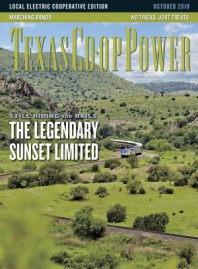More Than Electricity
Most co-op members just think about electricity when they think of their co-op, and I was in that group until my granddaughter, Logan Sisk, was chosen to attend the East Texas Rural Electric Youth Seminar at Lon Morris College in Jacksonville. Students were chosen from all the school districts in our area to attend, and I was so impressed with the range of meetings that was offered. And, too, our co-ops award scholarships.
So, I would like to send a big thanks to all the co-ops, and especially, my co-op, Panola-Harrison, for helping to assure that our youth have the character and values that will stay with them for life. Electricity is important, but so are our kids.
Gloria Creel, Panola-Harrison Electric Cooperative
Home, Sweet Energy-Saving Home
Your article on the Home Energy Makeover Winners (August 2010) was excellent—what a wonderful program. Each of these five families benefited tremendously and are now encouraging others to be more energy efficient. We just wish the “Extreme Makeover: Home Edition” television show would spread their resources around so that many more families could benefit.
Karen and Damian Andrus, Wood County Electric Cooperative
You noted [in the Home Energy Makeover story] that the Stark family’s home had six large recessed lights that “had no insulation, creating an energy drain …” Unless those lights were the thermally protected type, they should not have had insulation over them. Insulating over certain types of recessed lights can cause heat buildup that could lead to a fire. Better a little loss of energy than a house fire. The wise thing to do is to replace the lights with ones that can be safely insulated over.
Mrs. Lyn McCelvey, Lovelady Insulation Company, Houston County Electric Cooperative
Editor’s Note: Gabriel Castaneda of American Insulation explains: “The ceiling lighting in the Stark home was ‘energy rated,’ which allows for insulation within 3 inches of the lighting itself. But to be safe, Johns Manville insulation batts were placed over the top of the lighting compartments (which were 1 to 2 feet above the lighting) before any insulation was blown into the attic.”
Don’t Waste the Squeal
I always look forward to reading and trying out the delicious recipes in Texas Co-op Power magazine, and Tony’s Mojo Pork Roast is certainly a deserved winner. However, I must take exception to the old adage regarding “using everything from the pig but the squeal” referenced in the intro to the recipe. According my late father, a Depression-hardened old-timer who certainly did his share of hog butchering growing up on Pierce Ranch in Wharton County, the squeal was absolutely not to be wasted—that went in the Victrola! Thanks for an informative, thoroughly entertaining magazine.
Stephen L. Clarke, Wharton County Electric Cooperative
Erickson Reads Erickson
Our family was delighted to see your Co-op People feature of John Erickson in the August 2010 issue. His books have been a great reading motivator for some of our boys in particular. If you’ve never heard one of Mr. Erickson’s recordings of his own books, you’ve missed out on some hilarious adventures! They keep the whole family entertained while traveling and the driver wide awake!
Thank you for your informative little magazine.
Gloria Gohn, Farmers Electric Cooperative
Modern Ice Age
-

- Scott Dawson
Clay Coppedge’s article “An Era Frozen in Time” (August 2010) brought back some memories from my own childhood and seeing ice plants, ice delivery trucks and a few real “ice boxes” in homes during the late 1940s and 1950s in South Texas.
I also remember being told as a child upon visiting an ice plant in Jefferson in Northeast Texas that some of the first artificial ice was made in Jefferson right after the Civil War. Checking an online source I confirmed San Antonio’s first claim on ice manufacturing with a French-imported machine. However, according to the Handbook of Texas, a man named David Boyle invented the first ammonia-compression ice machine at a sawmill in Jefferson in 1873. He later took his invention to Chicago and joined a firm that started the mass production of his invention. Among his first buyers were the Capitol Ice Company of Austin and Richard King, founder of the King Ranch.
Douglas Beare, Pedernales Electric Cooperative
I loved “An Era Frozen in Time.” My grandmother had an icebox (I still call the refrigerator an “icebox”). On ice delivery day, the homeowner would set out a cardboard sign. It was about 12 inches square and had a specific poundage printed on each of the four sides—say 5, 10, 15 and 20. The sign was set up to indicate to the iceman how much ice they wanted that day. I must have been 4 or 5 (I’m 67 now) and riding in the front seat with my parents when we came upon a car towing a brand-new travel trailer with a temporary cardboard license plate on the back. I asked my mother how much ice they wanted.
Thanks for the memories.
(Ms.) Michael Davis, Medina Electric Cooperative
I enjoyed reading another perspective on iceboxes in the August 2010 issue of Texas Co-op Power. My grandfather, Carl Drachenberg, used an icebox until the late 1950s. He was a master cabinetmaker in Houston and was awarded the patent on the double-seal icebox in 1924. I remember the icebox he made, and he used it while I was growing up. I would love to locate one of his iceboxes. My cousin has one, but that is the only one I know of. My grandfather always put a label or metal plate on the back with his name on it.
Cynthia K Nelson, Sam Houston Electric Cooperative
I enjoyed “An Era Frozen in Time.” My parents owned ice plants in Conroe and Cleveland, Texas. Our two plants made 96 tons of ice in 24 hours. We pulled 1,200 pounds at a time. In World War II, we could not get tires and gas for trucks, so we delivered ice with wagons and mules. In our cold storage we stored Dairy Queen ice- cream mix, cold drinks, watermelons and cantaloupes in season. We made snow-cone ice and anything to generate income. My dad died in 1942, and my mother ran both plants and sold them in 1956. I know a real icehouse from today’s icehouse.
Harold Stillings, Navasota Valley Electric Cooperative
“An Era Frozen in Time” brought back memories of the early- to mid-1940s when my father, Preston Madison, drove an ice truck for the local grocery store and delivered ice to the people in rural Randolph. My sister, Joyce Reynolds, and I were allowed to ride with him on occasion. He also carried candy and gum for sale. One day a little boy, Billy Shelley, wanted five pieces of bubble gum, which was 5 cents. My daddy allowed him to count them out. After my daddy left, Billy found out that he had gotten six pieces instead of five. His brothers and sister tried all week to get him to let them chew the extra piece, but he would not. When my daddy returned the next week, he gave the gum back to my daddy.
I also remember that my sister and I had to go to the icehouse and get blocks of ice after my daddy no longer worked there. We took a stick and would put it through the twine, which was tied around the ice so we could carry it. My sister was older and taller, and therefore the ice would eventually slip down on my hand and we would have to set it down and move the stick. We never got home with a clean block of ice, but I don’t remember my mother complaining.
Thanks, Clay Coppedge, for the memories.
Sue Madison Orr, Fannin County Electric Cooperative
“An Era Frozen in Time”—what a story! So many of us never knew about the “ice” icebox and icehouse. What a true luxury ice really is. It’s sad to say that our big historical museums don’t tell about the ice and ice in the South. This story is fantastic.
I remember an old car my great uncle had when I was a child. By the windshield on the dash was a tray or box that held a block of ice. The wind would go through the vent onto the ice, and you would have cold air.
Please tell Clay Coppedge that I am going to frame the article.
Lawrence M. Malek, Fayette Electric Cooperative
What a wonderful article, “An Era Frozen in Time.” I remember it well! We lived in Pennsylvania then and we had a cellar, so the icebox leaked into the cellar by way of a small pipe in the bottom of the icebox. Otherwise, you had a pan you better remember to empty.
Mrs. James Badders, Bluebonnet Electric Cooperative
I recently was skimming through Texas Co-op Power magazine, and spotted “An Era Frozen in Time.” It was terrific and fascinating. My pop was from the hills of Kentucky. He told me how each winter he would pile all the cow and horse manure around the house up to the windows and sometimes the roof. Once the snows came, it froze and made terrific insulation for their small cabin. I’ve heard how they used cobs for firewood and toilet paper. I was born in 1950, in time for the TV, radio and cool air. But yesterday is still fascinating.
Frank Cashin, Orange Grove
Read All About It
Enjoyed your article about small West Texas newspapers in the August 2010 issue of Texas Co-op Power, but I thought you might like to know there are weekly newspapers smaller than those you talked about, and they are in an REA (electric cooperative) district. I own and have operated the Miles Messenger in Runnels County (Coleman County REA area); The Rowena Press, also in the same county and same REA area; and The Concho Herald in Paint Rock, the Concho County seat and in the Concho Valley REA area. The Messenger has a circulation of 600, the Press about 200 and the Herald about 200. I have been at this post since 1953 and have published each week these many years. My daughter, Donna Glass, is my editor and business manager. We publish each week of the year except between Christmas and New Year’s. Thanks for your time; I really enjoy your magazine.
Lonnie Rankin, Miles


